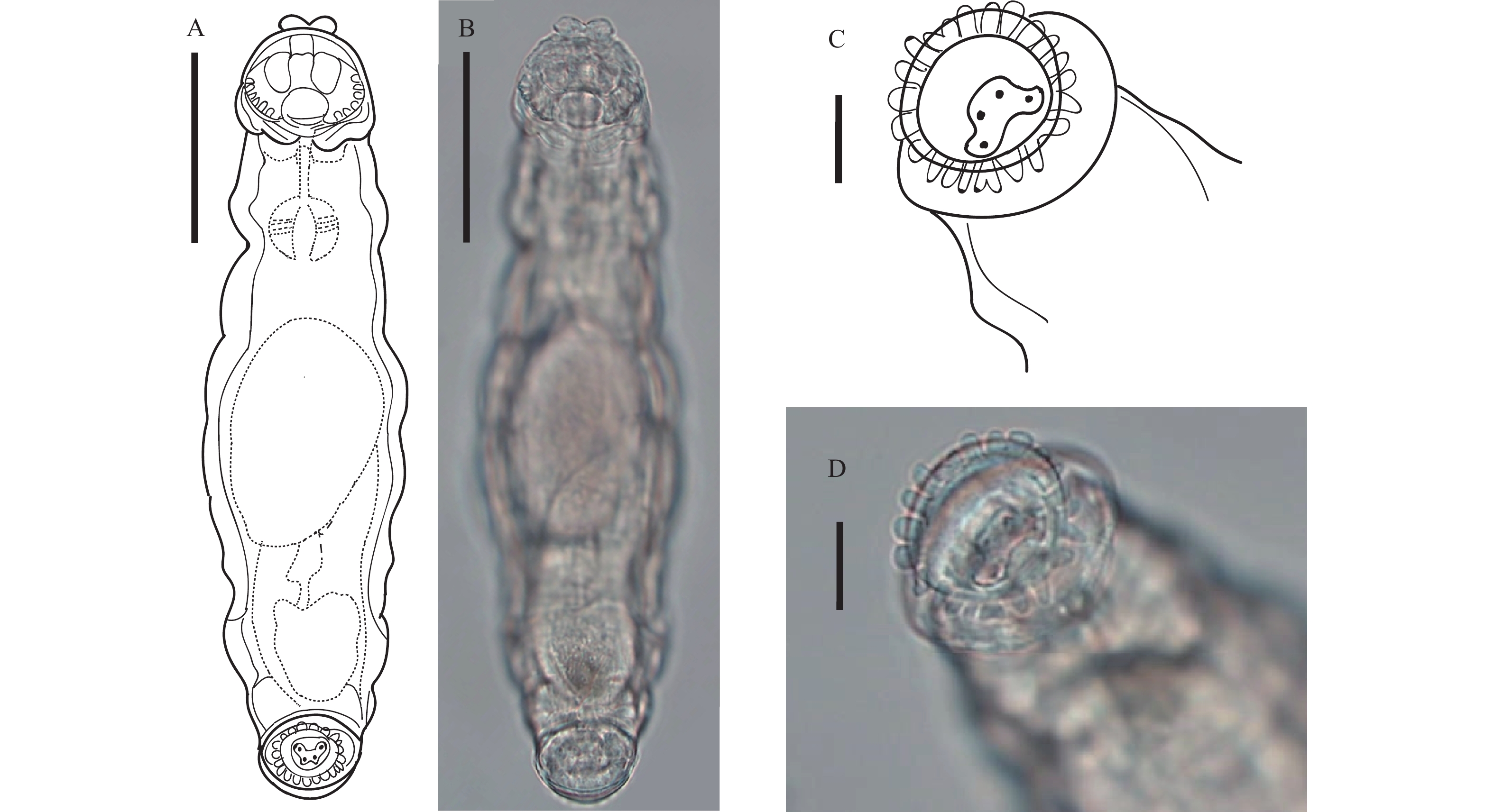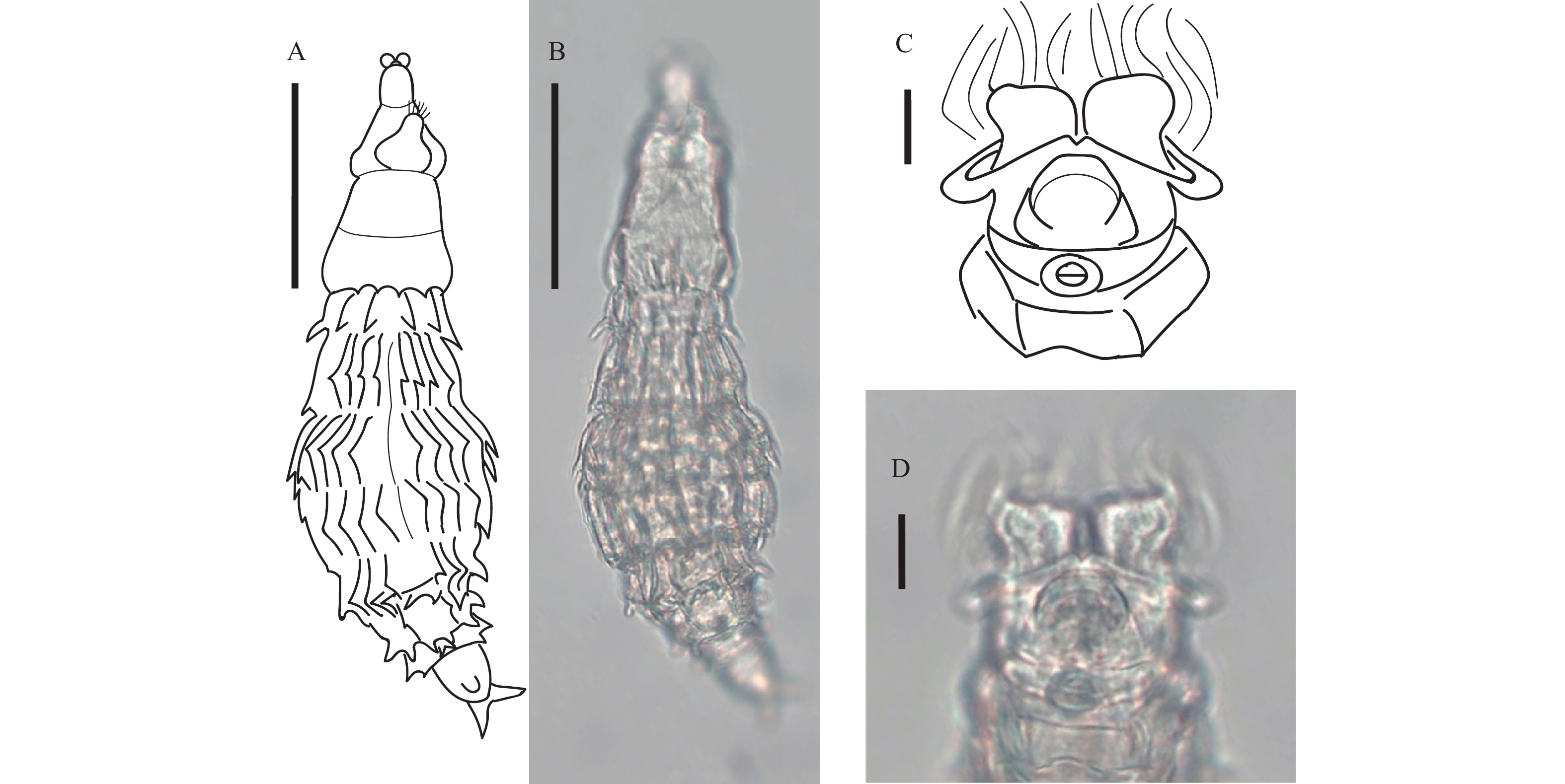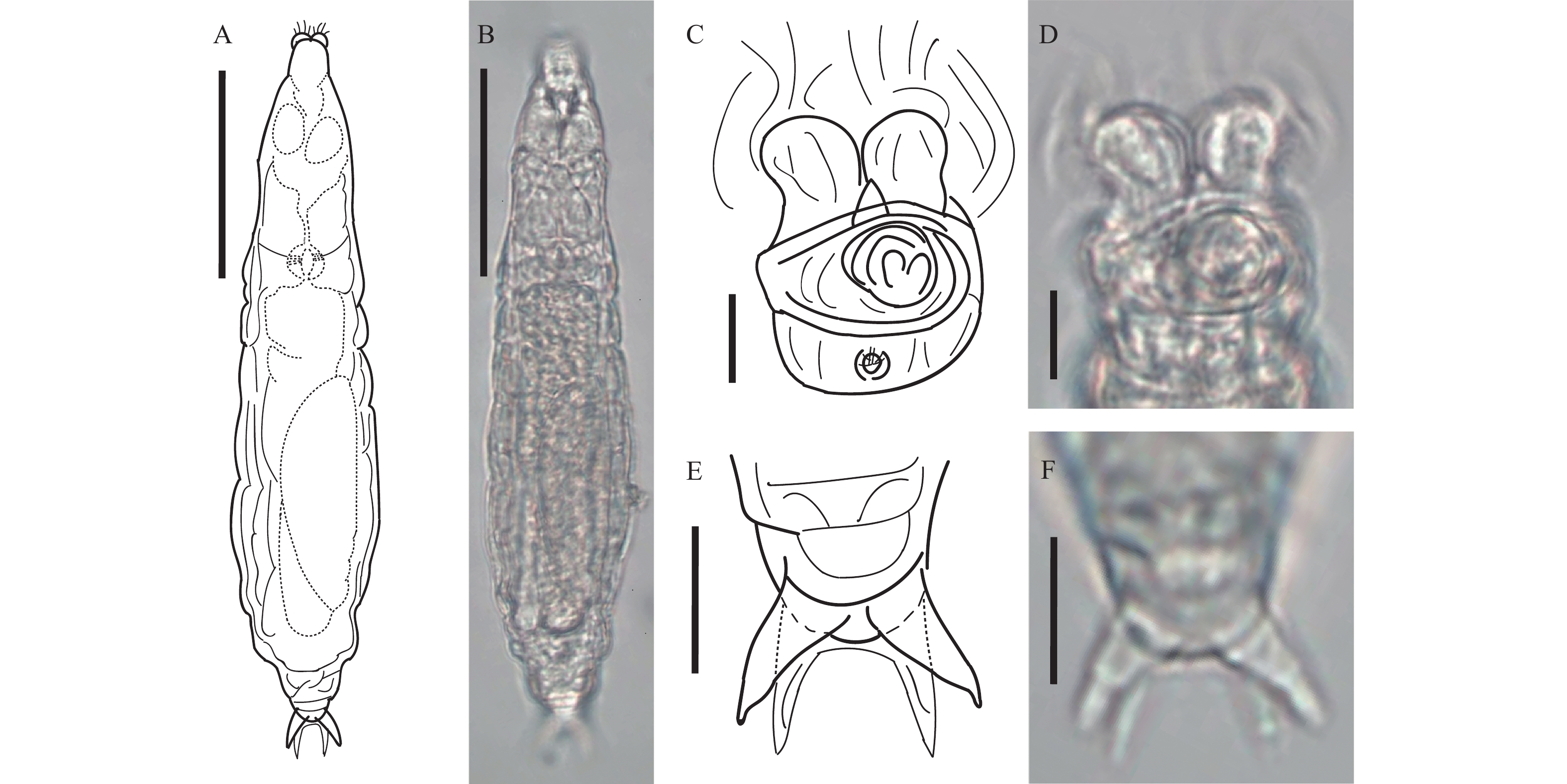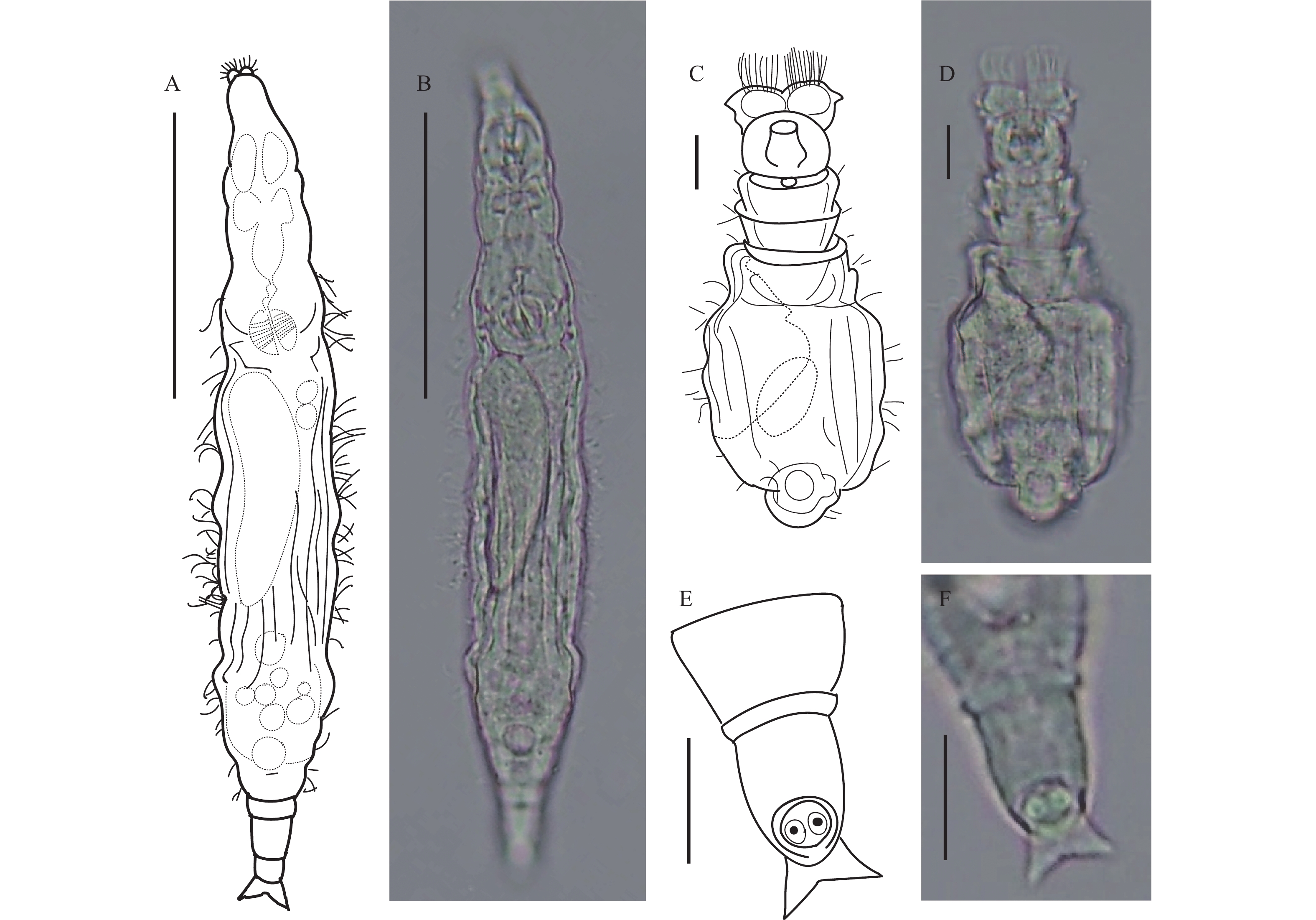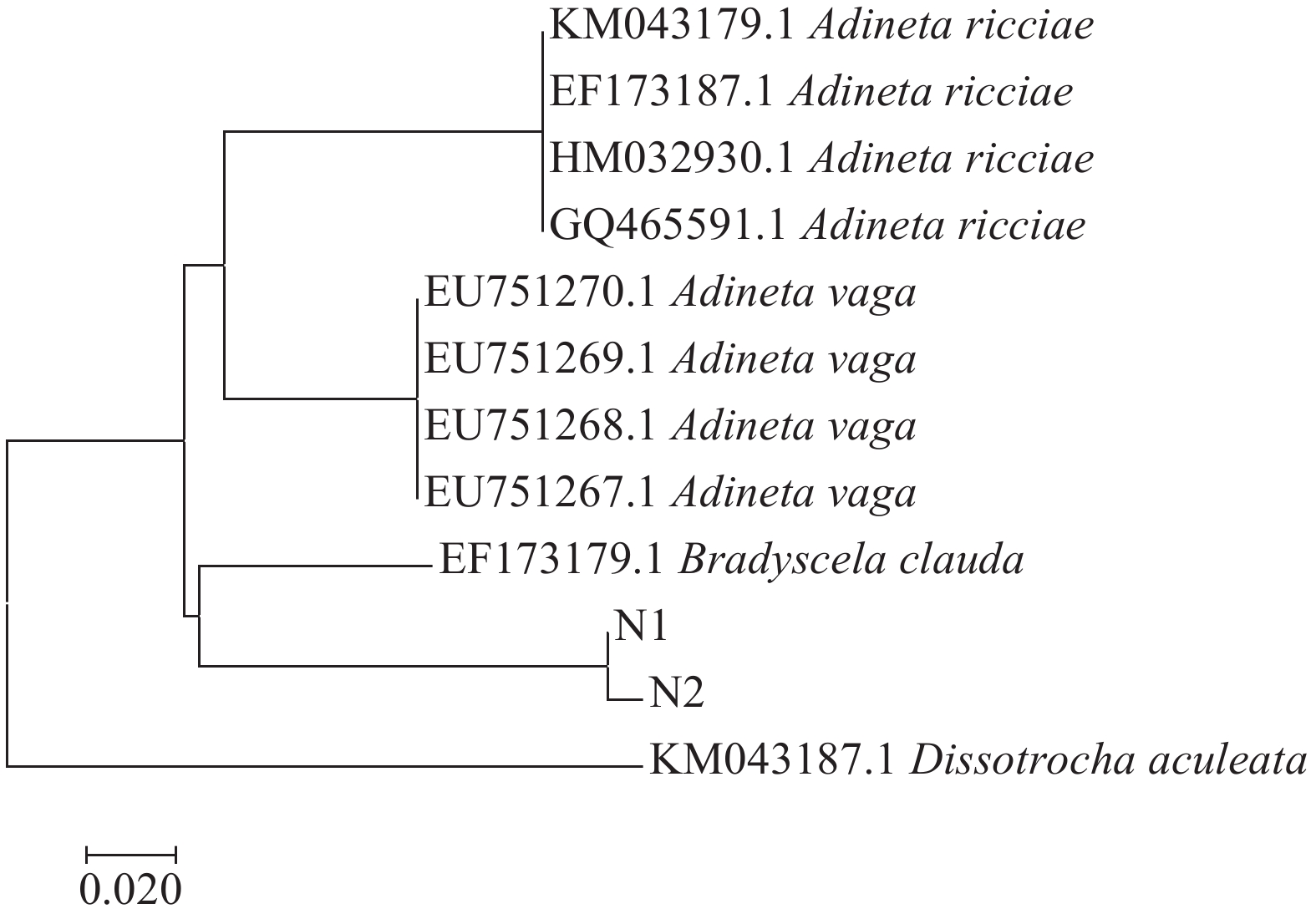SPECIES DIVERSITY OF BDELLOID ROTIFERS IN LEAF LITTER AND FOUR NEW RECORDS IN CHINA
-
摘要: 为研究落叶生境蛭态轮虫物种多样性, 对中国8省28个落叶样品进行了调查, 采样范围涵盖中国热带、亚热带及温带地区, 海拔高度从3 m到1500 m不等, 共记录蛭态轮虫3科8属29种, 其中中国新记录属1属, 中国新记录种4种, 将中国蛭态轮虫记录由88种增加到92种。研究获取了新记录种跛足突盘轮虫(Bradyscela clauda Bryce, 1893)的COⅠ序列, 与基因库中同科物种的COⅠ基因序列聚类比对, 证明了跛足突盘轮虫的遗传位置。结果表明, 落叶生境蛭态轮虫物种多样性较高。因此, 在调查苔藓和土壤等生境的同时, 应加强对落叶生境的研究力度, 以期发现更多的蛭态轮虫新记录种、特有种和新种。Abstract: Bdelloid rotifers are a group of microscopic invertebrates known for their obligate parthenogenesis and exceptional resistance to extreme environments. The capacity to maintain diapausing anhydrobiotic state as well as their microscopic dimensions contributed to an amazingly wide distribution of bdelloid rotifers. They can be found in both aquatic (mainly freshwater lakes, ponds and streams) and terrestrial (e. g. mosses, lichens, tree barks, soil and litters) habitats. However, the diversity and distributions of bdelloid rotifers are poorly studied in the world, especially in China. Leaf litter belongs to the litter layer in forest ecosystem, which is the main source of material and energy of soil ecosystem and plays an important role in quality maintenance and ecological function of soil. The existing studies on bdelloid rotifers are mainly restricted within few habitats such as water bodies, moss and soil. Rarely, bdelloids from the leaf litter environment are reported in the world. In order to better understand the species distribution and diversity of bdelloid rotifers in China, a survey of leaf litter habitats was conducted from 8 provinces of China. The sampling range included tropical, subtropical and temperate regions, with altitudes spanning from 3 m to 1500 m. Rotifers isolated from these samples were identified by both external morphology and anatomy using the keys of Donner (1965) and the original descriptions or redescriptions of specific species. All living specimens were recorded and photographed for species identification and measurement. In addition, we used HotSHOT technique to extracted DNA for amplifying partial COⅠ sequence of the new record B. clauda and downloaded some already published COⅠ sequences from GenBank including B. clauda from UK. Phylogenetic trees were constructed by using NJ method. In total, 29 morphospecies were identified in this study, representing 6.1% of the global bdelloid rotifers species diversity, and belonged to 8 genera and 3 families, including 4 new Chinese record species (Bradyscela clauda Bryce, 1893, Macrotrachela aculeata Milne, 1886, Philodina scabra Milne, 1916 and Scepanotrocha corniculate Bryce, 1910) and 1 new Chinese record genus (Bradyscela). Bdelloid rotifers species numbers increased from 88 to 92 in China. 2 species (M. aculeata and S. corniculate) were first reported in Asia and 4 new records were described. The results indicate the abundant existence of bdelloid rotifer species in the leaf litter habitats, which will require considerably greater efforts to survey the microscopic species in China. The genetic position of the species B. clauda in molecular phylogenetic tree was determined by comparing the COⅠ gene sequence, which is consistent with morphological taxonomy. The integration of morphological taxonomy and DNA taxonomy provided a strong support for the accurate description of new records B. clauda. This study provided new bdelloid data from China for enriching the knowledge of rotifer biodiversity and their global biogeography. In addition to conventional habitats such as moss and soil, our findings indicate that more attentions should be paid to habitats like leaf litter. Thus, further researches targeted to the bdelloid rotifers of China through integration of morphological and molecular biological approaches would identify considerably higher levels of diversity and increase the understanding of habitat preferences by bdelloid rotifers.
-
Keywords:
- Bdelloid rotifers /
- Leaf litter habitats /
- Taxonomy /
- New records /
- Species diversity
-
轮虫是一类水生或半水生小型无脊椎动物, 身体不分节, 两侧对称, 具有假体腔, 已记载轮虫2000余种[1]。轮虫个体小、繁殖快, 能快速占领生态位, 并作为微食物网的重要环节, 将初级生产力(如藻类、细菌)转化为次级消费者(如鱼类、昆虫幼虫、枝角类和桡足类)可利用的形式, 在水生和湿地生态系统物质循环和能量流动中具有重要的生态学意义。
蛭态轮虫是一类特殊的轮虫类群, 具有可以套筒式收缩和舒张的身体; 除盘网轮科外均具有一对发达的轮盘, 兼有运动和摄食功能, 盘网轮科轮虫头冠扁平, 无轮盘, 腹面有一具纤毛的盘网; 两对卵黄腺, 枝形咀嚼器。体长通常在200—500 μm, 某些种类如长足轮虫(Rotaria neptunia. Ehrenberg, 1830)可长达1.6 mm。蛭态轮虫具有两大特点: 孤雌生殖和低湿休眠[2]。孤雌生殖使其在不利环境下, 免受种群丰度降低所带来的灭绝风险, 并在环境条件适宜时迅速恢复种群数量。低湿休眠是指虫体由于失水而进入休眠状态, 形态特征和生理过程发生一系列变化, 从而在一定程度上抵御不利环境(干燥、低温、紫外线)所造成的影响, 并在环境条件改善时复苏[2]。因此, 蛭态轮虫适应性极强, 分布十分广泛, 大量存在于水体和陆生生境中。研究表明, 生活在一般水体中的轮虫, 20%—30%为蛭态轮虫; 在陆生生境中, 95%为蛭态轮虫[2]。陆生生境包括苔藓、地衣、土壤和落叶等。目前, 国内外蛭态轮虫相关研究主要关注前3种陆生生境, 特别是对苔藓中蛭态轮虫研究最多。相比其他生境, 苔藓中蛭态轮虫物种丰富度和丰度均较高, 与其复杂的内部结构和高含水量有密切关系[3]。已有调查对落叶生境关注度较低[4, 5], 偶见于部分蛭态轮虫物种多样性调查[6—8]。
落叶在森林生态系统中属于凋落物层。凋落物是土壤生态系统物质和能量的主要来源, 对土壤质量维护和土壤生态功能发挥具有重要作用[9]。凋落物具有适合生物生存的微生境, 其中生活着大量土壤动物(如蜱螨目、弹尾目)。土壤动物在凋落物分解过程中发挥着十分重要的作用[10]。现有研究主要关注凋落物中大中型土壤动物群落结构, 低估甚至忽略了轮虫现存量和生态作用。本研究旨在调查落叶生境蛭态轮虫物种多样性, 以期为进一步研究蛭态轮虫在落叶凋落物分解中的作用提供基础资料。
1. 材料与方法
1.1 采样地点与采样方法
2018年11月至2019年5月, 共采集中国8省12地区28个落叶样品, 采样范围涵盖我国热带、亚热带及温带地区, 海拔跨度为3至1500 m(表 1)。
表 1 采样点信息Table 1. Information of the sampling sites编号Locality code 地点Locality 落叶种类Leaf litter 采样日期Sampling date 坐标GPS coordinate 海拔Elevation (m) FJ1 福建福州 竹叶 2019-5-2 26°05′17.00′′N,119°14′05.00′′E 13 GD1 广东深圳 未知落叶 2019-5-2 22°34′00.33′′N,114°04′48.91′′E 176 GD2 广东深圳 橡胶榕叶 2019-5-2 22°33′59.57′′N,114°04′25.25′′E 36 GD3 广东顺德 细叶榕叶 2018-12-16 22°48′56.06′′N,113°08′39.01′′E 3 GD4 广东顺德 凤尾竹叶 2018-12-16 22°48′50.19′′N,113°08′55.98′′E 11 GD5 广东珠海 凤尾竹叶 2019-4-7 22°15′52.12′′N,113°34′39.09′′E 40 GZ1 贵州贵阳 凤尾竹叶 2019-5-3 26°19′58.34′′N,106°41′04.37′′E 1040 HB1 湖北孝感 竹叶 2019-2-19 30°56′13.15′′N,113°54′52.41′′E 30 HB2 湖北孝感 竹叶 2019-2-19 31°09′36.86′′N,114°07′07.37′′E 76 HN1 湖南常德 樟叶 2019-3-15 29°02′49.36′′N,111°40′02.11′′E 15 HN2 湖南常德 竹叶 2019-3-15 29°03′06.71′′N,111°40′03.81′′E 6 JS1 江苏淮安 玉兰叶 2019-1-11 33°35′48.08′′N,119°02′39.17′′E 29 JS2 江苏淮安 竹叶 2019-1-14 33°35′51.86′′N,119°02′38.94′′E 22 JS3 江苏淮安 竹叶 2019-1-14 33°35′50.99′′N,119°02′38.59′′E 31 JX1 江西南昌 凤尾竹叶 2018-12-14 28°41′41.18′′N,116°01′32.97′′E 41 JX2 江西南昌 苦棘叶 2018-12-14 28°53′36.25′′N,116°14′04.68′′E 11 SD1 山东泰安 未知落叶 2019-2-14 36°15′23.07′′N,117°06′11.81′′E 1500 ZJ1 浙江宁波 杜鹃花叶 2018-11-3 29°52′38.32′′N,121°33′16.06′′E 21 ZJ2 浙江宁波 银杏叶 2018-11-3 29°52′36.45′′N,121°33′15.91′′E 30 ZJ3 浙江舟山 红花檵木叶 2018-11-4 29°59′31.41′′N,122°12′09.45′′E 158 ZJ4 浙江舟山 女贞叶 2018-11-4 29°59′31.01′′N,127°12′07.96′′E 46 ZJ5 浙江舟山 柳树叶 2018-11-4 29°59′22.78′′N,122°12′24.46′′E 36 ZJ6 浙江舟山 竹叶 2018-11-4 29°59′30.18′′N,122°12′07.63′′E 22 落叶样品通过手捡法采集, 随即放入牛皮种子袋中, 并在种子袋表面标注落叶种类、地点、日期和海拔高度等信息。样品带回实验室后, 室温下自然风干后保存。
1.2 蛭态轮虫的分离与提取
采用震荡复苏法分离落叶中蛭态轮虫, 取部分风干后的落叶样品放入250 mL锥形瓶中, 加入超纯水至没过样品, 在培养箱中20℃恒温黑暗培养24h使其复苏。在培养完毕后, 将样品放在涡旋振荡仪上震荡15s, 随即将液体部分倒入30 μm孔径网筛中过滤, 以上操作重复3次。用超纯水冲洗网内残留物至培养皿或5 mL浮游生物计数框内进行镜检观察[11]。
1.3 形态学鉴定
将盛有蛭态轮虫样品的培养皿或浮游动物计数框置于体视显微镜下, 用玻璃毛细管挑取单个虫体于载玻片上并添加少量超纯水, 加盖玻片后于具拍照系统的正立荧光显微镜下观察其形态学特征, 拍照作为鉴定依据, 通过TCapture成像软件对蛭态轮虫体长、体宽和头冠宽等重要性状进行测量, 测量系统和方式依据Yakovenko等[12]提出的形态学测量模型, 包括总长(TL)、体宽(BW)、头冠宽(CW)、头长(HL)、头宽(HW)、颈长(NL)、最大颈宽(MxNW)、最小颈宽(MinNW)、咀嚼器长(RaL)、咀嚼器宽(RaW)、臀长(RL)、臀宽(RW)、腿长(FL)、腿宽(FW)、足刺长(SL)和足刺间隔宽(SSW)。使用Adobe Illustrator CC 2014绘制蛭态轮虫形态模式图。鉴定主要参考依据为王家楫[13]和Donner[14]的轮虫分类专著及分类数据库www.rotifera.hausdernatur.at。
1.4 新记录种跛足突盘轮虫Bradyscela clauda的COⅠ基因扩增与系统发育进化树分析
本文采用HotSHOT法提取单只蛭态轮虫DNA[15], 用毛细管挑取跛足突盘轮虫B. clauda若干只于载玻片上, 超纯水清洗2—3次至体表无杂质, 将单个虫体放入0.2 mL PCR管中, 加入碱性裂解液10 μL, 用显微镊破碎虫体, 95℃裂解0.5h后取出立即放入–20℃冰箱内冷却10—15min, 加入中和液10 μL, 即完成DNA提取。使用引物(ZplankF1_t1: 5′-TGTAAAACGACGGCCAGTTCTASWAATCATAARGATATTGG-3′; ZplankR1_t1: 5′-CAGGAAACAGCTATGACTTCAGGRTGRCCRAARAATCA-3′)进行PCR扩增, 扩增反应体系25 μL, 包含2×Gflex PCR Buffer (Mg2+, dNTP plus) 12.5 μL, 引物各0.5 μL, 模板5 μL, Tks Gflex DNA Polymerase 0.5 μL, ddH2O 6 μL。引物反应程序: 95℃预变性1min, 94℃变性40s→45℃退火40s→72℃延伸45s, 循环5次, 94℃变性40s→51℃循环退火40s→72℃循环延伸45s, 循环35次, 72℃延伸5min→保存[16]。1%琼脂糖凝胶电泳检测PCR产物, 若目标条带较浅, 则将模版稀释95%后用Bdell_COI_FW: 5′-CGTACWGAGTTAGGAATRGTA-3′和 Bdell_COI_Rev: 5′-CCAAAATTWCGATCTAAYA-3′引物进行巢式PCR扩增, 1%琼脂糖凝胶电泳检测PCR产物后测序。将本研究获得序列于NCBI进行Blast比对, 下载得分最高的参考序列, 使用MEGA7软件采用邻接法(Neighbor-Joining method)构建系统发育进化树。
2. 结果
本研究共记录蛭态轮虫3科8属29种(表 2), 占全球已发现蛭态轮虫物种多样性的6.1%, 其中1属(Bradyscela)和4种(B. clauda, Macrotrachela aculeata Milne, 1886, Philodina scabra Milne, 1916和Scepanotrocha corniculata Bryce, 1910)为我国首次记录。
表 2 蛭态轮虫物种名录Table 2. The species list of bdelloid rotifers科Family 属Genus 种Species 采样点Locality 盘网轮科Adinetidae 盘网轮属Adineta 楔足盘网轮虫Adineta cuneata Milne, 1916 JS1, JS2, GD3 贝氏盘网轮虫A. beysunae Örstan, 2018 ZJ6, GD3, GD4, GD5, JS3, GZ1 具眼盘网轮虫A. oculata Milne, 1886 GD1 游荡盘网轮虫A. vaga Davis, 1873 ZJ4, HN2, JX1, JS3, HB1, GZ1, GD3 突盘轮属Bradyscela 跛足突盘轮虫B. clauda Bryce, 1893* HN2, GD4, JS2 宿轮科Habrotrochidae 宿轮属Habrotrocha 缢缩宿轮虫Habrotrocha constricta Dujardin, 1841 JX1, GZ1, GD3 弯唇宿轮虫H. thienemanni Hauer, 1924 HN2 双齿宿轮虫H. bidens Gosse, 1851 GD5, JS3, HB1, GZ1, GD3 罗莎宿轮虫H. rosa Donner, 1949 HN1, GZ1 舌突宿轮虫H. ligula Bryce, 1913 GD5, GD3, JS3, ZJ2 围轮属Scepanotrocha 角萼围轮虫Scepanotrocha corniculata Bryce, 1910 * ZJ4 旋轮科Philodinidae 粗颈轮属Macrotrachela 四角粗颈轮虫Macrotrachela quadricornifera Milne, 1886 HN2, GD5, ZJ6, GZ1 乳突粗颈轮虫M. papillosa Thompson, 1892 GD4 奇异粗颈轮虫M. insolita De Koning, 1947 HN2, ZJ6, GD5 游离粗颈轮虫M. libera Donner, 1949 ZJ6 尖刺粗颈轮虫M. aculeata Milne, 1886* ZJ6, GZ1 多刺粗颈轮虫M. multispinosa Thompson, 1892 ZJ6, HN2, GD5, JS3, GZ1 栖居粗颈轮虫M. habita Bryce, 1894 GD5, HB1 无刺粗颈轮虫M. inermis Donner, 1965 SD1 欧氏粗颈轮虫M. ehrenbergii Janson, 1893 ZJ3 一种粗颈轮虫Macrotrachela sp. 1 JS3 旋轮属Philodina 强壮旋轮虫Philodina proterva Milne, 1916 ZJ4, ZJ3, JS3, GD3 宽体旋轮虫P. plena Bryce, 1894 ZJ6, JS3, HB1, GD3, JS1 微戟旋轮虫P. parvicalcar De Koning, 1947 JS3 迅捷旋轮虫P. rapida Milne, 1916 GD5 印度旋轮虫P. indica Murray, 1906 HB1, JS2 粗糙旋轮虫P. scabra Milne, 1916* ZJ1 宁静旋轮虫P. tranquilla Wulfert, 1942 GD2 轮虫属Rotaria 污轮虫Rotaria sordida Western, 1893 JX1, ZJ6, GD5, GZ1, ZJ2, JS2 注: * 表示中国新记录种; JS. 江苏; GD. 广东; ZJ. 浙江; GZ. 贵州; HN. 湖南; JX. 江西; HB. 湖北; SD. 山东Note: * means New records in China; JS. Jiangsu; GD. Guangdong; ZJ. Zhejiang; GZ. Guizhou; HN. Hunan; JX. Jiangxi; HB. Hubei; SD. Shandong 2.1 新记录种形态学描述
跛足突盘轮虫, 新记录种Bradyscela clauda
身体浅褐色, 皮肤表面有颗粒状点纹, 躯干侧面有纵向皮肤褶, 形似蠕虫状。喙片二裂片, 其宽度约为最大头宽的一半。头长与头宽相近, 爬行时, 最大头宽略小于躯干最宽处。两侧耙各具6个齿状缺刻, 摄食时, 跛足突盘轮虫的耙较灵活, 可以自由张合刮取食物。咀嚼器齿式为2/2, 背触手短, 无眼点。足部短, 末端形成一吸盘状圆盘, 第一伪足节中间位置有一环形肿胀, 第二伪足节末端有一圈21个短的、瘤状的乳突。具三个短且粗壮的趾, 无刺戟。卵生。跛足突盘轮虫足部伸展缓慢, 爬行运动迟钝, 不具有如盘网轮属轮虫快速向前滑行的运动能力(图 1)。
![]() 图 1 跛足突盘轮虫A、B. 爬行状态腹面观, 比例尺: 50 μm; C、D. 爬行状态足部腹面观, 比例尺: 10 μmFigure 1. Bradyscela clauda Bryce, 1893A, B. Creeping, ventral view. Scale bars represent 50 μm; C, D. Creeping (foot), ventral view. Scale bars represent 10 μm; TL 234.7 μm; BW 68.3 μm; HL 39.3 μm; HW 46.1 μm; NL 80.5 μm; MxNW 51.8 μm; MinNW 39.8 μm; RaL 15.2 μm; RaW 7.9 μm; RL 48.2 μm; RW 56.2 μm; FL 23.6 μm; FW 39.3 μm
图 1 跛足突盘轮虫A、B. 爬行状态腹面观, 比例尺: 50 μm; C、D. 爬行状态足部腹面观, 比例尺: 10 μmFigure 1. Bradyscela clauda Bryce, 1893A, B. Creeping, ventral view. Scale bars represent 50 μm; C, D. Creeping (foot), ventral view. Scale bars represent 10 μm; TL 234.7 μm; BW 68.3 μm; HL 39.3 μm; HW 46.1 μm; NL 80.5 μm; MxNW 51.8 μm; MinNW 39.8 μm; RaL 15.2 μm; RaW 7.9 μm; RL 48.2 μm; RW 56.2 μm; FL 23.6 μm; FW 39.3 μm尖刺粗颈轮虫, 新记录种Macrotrachela aculeata
体型呈纺锤形, 躯干皮肤表面规律排列有许多体刺, 该特征与多刺粗颈轮虫M. multispinosa相似, 但存在不同。尖刺粗颈轮虫体刺较短, 规律排布在躯干每一伪体节上: 躯干第一和第二伪体节处各具一组体刺; 第三和第四伪体节处各具一组体刺, 且其中一组体刺位于躯干最宽处; 第五和第六伪体节处即臀部具三组体刺, 其中两组体刺位于第六伪体节。尖刺粗颈轮虫躯干部皮肤表面具有横向和纵向的皮肤褶, 上述体刺按照皮肤褶分布规律排布, 均朝向足部方向。喙长, 半圆形二裂片。在摄食状态下, 轮盘宽度与头宽一致, 具有发达的纤毛区和感觉刚毛; 瓣环发达, 从背面观察, 两侧明显凸出于头部; 上唇片形成一“V”形缺口(图 2C和2D)。背触手发达。咀嚼器齿式为2/2。足部第二伪体节背部中央有一明显增厚凸出的附属物。刺戟宽度较窄, 逐渐变尖细, 有间距。无眼点。趾3个。卵生。
![]() 图 2 尖刺粗颈轮虫A、B. 爬行背面观, 比例尺: 50 μm; C、D. 摄食状态头部背面观, 比例尺: 10 μmFigure 2. Macrotrachela aculeata Milne, 1886A, B. Creeping, dorsal view. Scale bars represent 50 μm; C, D. Feeding(head), dorsal view. Scale bars represent 10 μm. TL 208.3 μm; BW 52.7 μm; CW 29.5 μm; HL 31.3 μm; HW 32.6 μm; NL 17.9 μm; MxNW 34.3 μm; MinNW 28.9 μm; RaL 15.3 μm; RaW 8.2 μm; RL 25.6 μm; RW 36.6 μm; FL 26.6 μm; FW 21.0 μm; SL 11.3 μm; SSW 8.2 μm
图 2 尖刺粗颈轮虫A、B. 爬行背面观, 比例尺: 50 μm; C、D. 摄食状态头部背面观, 比例尺: 10 μmFigure 2. Macrotrachela aculeata Milne, 1886A, B. Creeping, dorsal view. Scale bars represent 50 μm; C, D. Feeding(head), dorsal view. Scale bars represent 10 μm. TL 208.3 μm; BW 52.7 μm; CW 29.5 μm; HL 31.3 μm; HW 32.6 μm; NL 17.9 μm; MxNW 34.3 μm; MinNW 28.9 μm; RaL 15.3 μm; RaW 8.2 μm; RL 25.6 μm; RW 36.6 μm; FL 26.6 μm; FW 21.0 μm; SL 11.3 μm; SSW 8.2 μm粗糙旋轮虫, 新记录种Philodina scabra
体型较小, 呈纺锤形。躯干皮肤粗糙, 有纵向皮肤褶, 呈灰褐色, 不透明。喙发达, 二裂片。摄食状态下, 轮盘宽度小于头部宽度, 两个轮柱紧密靠在一起, 轮槽很窄; 上唇片形状为平缓的弓形, 中间位置有一三角形突起。最突出的特征是倒数第二伪足节处着生有上下两对刺戟, 上方一对刺戟基部较宽, 后逐渐变尖细, 无足间距, 下方一对刺戟较细, 有足间距。这是迄今为止有记录的唯一具有两对刺戟的蛭态轮虫。趾4个。咀嚼器齿式为1+2/2+1(图 3)。
![]() 图 3 粗糙旋轮虫A、B. 爬行状态背面观, 比例尺: 50 μm; C、D. 摄食状态头部背面观, 比例尺: 10 μm; E、F. 爬行状态足部背面观, 比例尺: 10 μmFigure 3. Philodina scabra Milne, 1916A, B. Feeding, dorsal view. Scale bars represent 50 μm; C, D. Feeding (head), dorsal view. Scale bars represent 10 μm; E, F. Creeping (foot), dorsal view. Scale bars represent 10 μm. TL 202.7 μm; BW 42.5 μm; CW 25.4 μm; HL 27.1 μm; HW 28.5 μm; NL 24.3 μm; MxNW 28.9 μm; MinNW 26.5 μm; RaL 11.1 μm; RaW 7.3 μm; RL 18 μm; RW 28 μm; FL 11.5 μm; FW 14.7 μm; SL (broad) 11.6 μm; SL (thin) 11.9 μm; SSW (thin) 8.6 μm
图 3 粗糙旋轮虫A、B. 爬行状态背面观, 比例尺: 50 μm; C、D. 摄食状态头部背面观, 比例尺: 10 μm; E、F. 爬行状态足部背面观, 比例尺: 10 μmFigure 3. Philodina scabra Milne, 1916A, B. Feeding, dorsal view. Scale bars represent 50 μm; C, D. Feeding (head), dorsal view. Scale bars represent 10 μm; E, F. Creeping (foot), dorsal view. Scale bars represent 10 μm. TL 202.7 μm; BW 42.5 μm; CW 25.4 μm; HL 27.1 μm; HW 28.5 μm; NL 24.3 μm; MxNW 28.9 μm; MinNW 26.5 μm; RaL 11.1 μm; RaW 7.3 μm; RL 18 μm; RW 28 μm; FL 11.5 μm; FW 14.7 μm; SL (broad) 11.6 μm; SL (thin) 11.9 μm; SSW (thin) 8.6 μm角萼围轮虫, 新记录种Scepanotrocha corniculata
角萼围轮虫以食物泡为消化方式。体型小, 皮肤透明, 体表着生有许多小刺毛。围轮属的显著分类特征是其轮盘周围有一兜帽状结构, 背面观能观察到两个轮盘上伸出的发达纤毛, 兜帽结构可能是上唇片的一种变形。角萼围轮虫的兜帽状结构宽度大于头宽, 中央有一向下较深的凹陷, 且兜帽结构两侧中间位置有一水平向外的凸出。刺戟短, 足间距窄。趾2个, 短。咀嚼器齿式为4/4。卵生。爬行速度慢 (图 4)。
![]() 图 4 角萼围轮虫A、B. 爬行状态背面观, 比例尺: 50 μm; C、D. 摄食状态背面观, 比例尺: 10 μm; E、F. 爬行状态足部腹面观, 比例尺: 10 μmFigure 4. Scepanotrocha corniculata Bryce, 1910A, B. Feeding, dorsal view. Scale bars represent 50 μm; C, D. Feeding, dorsal view. Scale bars represent 10 μm; E, F. Creeping (foot), ventral view. Scale bars represent 10 μm. TL 164.6 μm; BW 26.7 μm; CW 18.2 μm; HL 19.5 μm; HW 17.3 μm; NL 27.2 μm; MxNW 18.7 μm; MinNW 12.8 μm; RaL 9.6 μm; RaW 5.3 μm; RL 32.5 μm; RW 26.7 μm; FL 15.4 μm; FW 11.3 μm; SL 7.4 μm; SSW 5.5 μm
图 4 角萼围轮虫A、B. 爬行状态背面观, 比例尺: 50 μm; C、D. 摄食状态背面观, 比例尺: 10 μm; E、F. 爬行状态足部腹面观, 比例尺: 10 μmFigure 4. Scepanotrocha corniculata Bryce, 1910A, B. Feeding, dorsal view. Scale bars represent 50 μm; C, D. Feeding, dorsal view. Scale bars represent 10 μm; E, F. Creeping (foot), ventral view. Scale bars represent 10 μm. TL 164.6 μm; BW 26.7 μm; CW 18.2 μm; HL 19.5 μm; HW 17.3 μm; NL 27.2 μm; MxNW 18.7 μm; MinNW 12.8 μm; RaL 9.6 μm; RaW 5.3 μm; RL 32.5 μm; RW 26.7 μm; FL 15.4 μm; FW 11.3 μm; SL 7.4 μm; SSW 5.5 μm2.2 跛足突盘轮虫, 新记录种Bradyscela clauda进化树分析及分子分类学地位
从GenBank中下载与本研究所获得跛足突盘轮虫B. clauda COⅠ基因序列相似度高的物种基因序列, 以旋轮科间盘轮属Dissotrocha aculeata Ehrenberg, 1830作为跛足突盘轮虫B. clauda的外类群, 盘网轮科盘网轮属A. vaga和A. ricciae作为同科物种, 使用邻接法构建系统发育进化树。由图 5可知, 本研究所获得的两条序列(N1-N2)与来自英国的跛足突盘轮虫序列(EF173179.1)相似度最高, 聚为一支, 后与同科Adineta属两种轮虫序列聚集在一起。聚类分析结果表明该轮虫属于蛭态亚纲盘网轮科突盘轮属, 以COⅠ基因条形码技术验证了形态学鉴定的结果。
3. 讨论
3.1 新记录种分类讨论
跛足突盘轮虫Bradycela clauda 突盘轮属在中国属首次记录。该属共记录轮虫3种, 分别是B. clauda、B. granulosa De Koning, 1947和B. hoonsooi Song, 2015, 三种形态学特征相似, 主要区别在于耙上齿状缺刻数目、第二伪足节处有无乳突及乳突大小和数量[17]。跛足突盘轮虫最早是Bryce(1893)在苔藓生境中发现, 当时未将该种从盘网轮属中分离出来, 仅作为盘网轮属的一个新种记录下来[18]。本研究所观察的跛足突盘轮虫与Bryce描述的种类存在差异, Bryce描述的种类第二伪足节处仅有10个乳突[18], 而本研究描述的种类第二伪足节处有23个乳突, 与Song[17]在韩国所观察的种类乳突数量相同。Bryce[18]认为该轮虫有许多变种。因此需要进一步观察和比较, 并应用DNA条形码等技术, 以确定其是否为同一种类的不同变种。
尖刺粗颈轮虫Macrotrachela aculeata 尖刺粗颈轮虫最早由Milne[19]发现, 但由于样本数量少, 故描述比较简单, 并且对体刺数量和位置描述不够准确, 与后来文献记载存在出入。Murray[20, 21]分别在南非和爱尔兰发现了该种及形态特征不同的几个变种并对它们进行了详细描述, 其中南非的种类与本研究所观察到的种类较相似, 均具7组体刺, 且排布方式相同。Bartoš[22]在捷克境内也发现了该轮虫。在他看来, 不同研究者对该轮虫的描述存在很大出入, 这其中可能蕴藏着不同种类, 或者说该轮虫具有很多变种。Donner[14]编写的蛭态轮虫检索表中, 将粗颈轮属中体表具有附属物的轮虫编辑在一起, 根据附属物的形状、大小、数量和在躯体上的排列进行分类。本研究是尖刺粗颈轮虫在亚洲区系的首次记录, 以往的研究主要集中在欧洲和南非。
粗糙旋轮虫Philodina scabra Milne[23]在南非的苔藓生境中首次观察到粗糙旋轮虫并对其进行了详细描述, 形容其躯干皮肤粗糙有沟痕, 像树皮一样。该轮虫到底存在几个趾, Milne[23]尚无定论。同时, 该轮虫无论体型还是轮盘、足部等细节特征, 都与粗颈轮属相似。因此, Milne[23]对该轮虫的分类归属保留怀疑态度, 暂且将其归入旋轮属。粗糙旋轮虫较稀有, 很长一段时间世界上都没有该轮虫的相关报道。直到2017年, Song等[24]在韩国观察到该轮虫及其4趾, 最终确定了其分类归属。不过, 对于粗糙旋轮虫两对刺戟位置目前还存在争议: Song等[24]记录的种类较细一对刺戟位于上方, 而较粗一对刺戟位于下方, 与Milne[23]原始文献中描述情况相反。本研究观察到粗糙旋轮虫两对刺戟排列位置与Milne[23]描述相同。这可能是由于显微镜下光与影的错觉, 使Song等[24]得出了不同结论, 也可能是粗糙旋轮虫存在不同变种。需要我们获得更多样本, 使用更先进的成像技术观察并运用分子生物学手段比较。
角萼围轮虫Scepanotrocha corniculata Bryce[25]在英国一苔藓生境中最早发现角萼围轮虫。他认为该轮虫一般特征与其他轮虫并无区别, 只有在摄食状态下, 才能观察到其特有的兜帽结构。目前共记载围轮属蛭态轮虫12种, 头部均具有兜帽结构, 彼此之间通过该结构的形状、大小等特征加以区分[14]。其中, 角萼围轮虫S. corniculata与S. Haueri Donner, 1962, S. simplex De Koning, 1947和S. parva Schulte, 1954等相似。S. corniculata与S. simplex的区别在于前者兜帽结构前端中央存在一向下的凹陷, 而S. simplex不具有此凹陷; 与S. haveri之间区别在于S. corniculata的兜帽结构完全覆盖住轮盘, 中央凹陷较深, 而S. haveri的兜帽结构刚好覆盖住轮盘, 其边缘与轮盘边缘很接近, 但并不贴合, 且中央凹陷较浅; 至于S. parva, 该轮虫兜帽结构两侧边缘的中间位置无水平扩展[14]。另外, 本文所观察的种类体表具有许多小刺毛, 这在Byrce[25]的报道和Donner[14]编写的检索表中皆未提到。推测本研究发现该轮虫的采样地点(浙江舟山)风力较大, S. corniculata为适应多风环境, 增大自身固着能力而形成这一变种。本研究是该轮虫在亚洲区系的首次记录。
3.2 蛭态轮虫栖息生境研究现状
关于蛭态轮虫栖息地, 主要有两种类型, 一是湖泊、河流、溪流等水生生境, 二是苔藓、地衣、落叶和土壤等陆生生境。除此之外, 一些特殊生境也引起研究者们的极大兴趣, 如种子、蘑菇等。就物种多样性丰富程度而言, 与其他类群轮虫不同的是, 95%的蛭态轮虫生活在不稳定的陆生生境中, 而栖息于淡水生境中的蛭态轮虫, 常见的只有10种左右[13], 这可能与蛭态轮虫低湿休眠和孤雌生殖的生活史策略有关。有研究者认为, 蛭态轮虫经历低湿休眠后, 繁殖力会显著提高, 有助于保持适合度成分(Fitness components)的稳定[26]。并且, 严格孤雌生殖使它们能够快速大量繁殖和传播, 迅速占领栖息地, 快速适应多变或不稳定的陆生环境。
在陆生生境方面, 对苔藓生境蛭态轮虫研究最多(表 3)。有研究者调查了2种不同生长年龄苔藓与蛭态轮虫物种组成之间的关系, 发现物种丰富度与苔藓的生长年龄呈正相关, 且那些含水量高和结构复杂的苔藓种类有更高的蛭态轮虫丰度和物种多样性[3]。目前, 蛭态轮虫物种组成与其栖息的苔藓物种特异性关系还未明晰, 物种对栖息生境植物种类的偏好不明显[27]。其次, 研究较多的生境是土壤。Devetter[28]曾调查捷克境内克列特山保护区林下土壤蛭态轮虫群落的时空变化, 发现轮虫种类、丰度及物种多样性与季节变化和土壤深度有密切关系; 他们认为土壤蛭态轮虫群落是一原生群落, 包含一些适应土壤生境的特有种。相比之下, 有关落叶生境中蛭态轮虫群落结构时空变化的研究则较少, 大部分研究仅限于落叶生境蛭态轮虫的定性观察。主要原因有: (1)相较其他两种陆地生境, 落叶生境不稳定。由于落叶脱离植物体, 丧失保水能力等自我保护和调节机制, 相较于苔藓生境更易受外界环境变化的影响, 温度、含水量等对生命活动至关重要的环境因子波动较大。(2)落叶本身在形态、结构、质量等方面差别较大, 即便是同种植物落叶, 其质量等特性随腐化程度不同, 存在很大差别。相比之下, 同一样点内土壤生境环境因子差别不大。目前对落叶生境中蛭态轮虫群落结构的研究, 尚无科学定量标准。
表 3 不同生境蛭态轮虫种类数量的比较Table 3. Comparison of species number of bdelloid rotifers in the different habitats研究国家/地区
Country/Region生境类型
Habitat样品数量
Sample size记录种类数量
Number of species文献
Literature乌克兰Ukraine 水生生境: 河流及水库(附着和底栖); 陆生生境: 苔藓、地衣、土壤 100份 53种 Yakovenko[29] 捷克Czech Republic 土壤 5份 22种 Devetter[6] 土耳其Turkey 水生生境: 水库、池塘、溪流; 陆生生境: 苔藓、地衣、土壤、蘑菇 45份 41种 Kaya等[30] 波兰Poland 水生生境; 陆生生境: 苔藓、地衣、落叶 17份 23种 Bielańska-Grajner等[8] 匈牙利Hungary 土壤 16份 24种 Schoell和Devetter[7] 土耳其Turkey 苔藓、地衣 30份 33种 Kaya[4] 南极洲Antarctica 水生生境: 池塘(沉积物); 陆生生境: 苔藓、土壤、地衣、藻丛 237份以上 60种 Yakovenko等[12] 白俄罗斯Belarus 水生生境: 湖泊、河流、水库、池塘、融雪性临时水体; 陆生生境: 苔藓、地衣、落叶 422份 93种 Lukashanets[5] 中国China 水生生境: 湖泊、河流、水库、池塘、稻田、溪流、沼泽、水坑、融雪水体、泉水、水生植物等附着; 陆生生境: 苔藓 未知 42种 Zhuge等[31] 中国China 苔藓 40份 16种 尹志伟和徐润林[32] 中国China 水生生境(浮游、底栖、附着、露水); 陆生生境: 苔藓、地衣、土壤、落叶 60份 59种 Zeng等[33] 中国China 落叶 28份 29种 本研究 3.3 落叶生境蛭态轮虫研究展望
落叶作为一种特殊生境, 具有较高的研究价值。第一, 落叶及其他凋落物是森林生态系统物质循环中不可或缺的部分, 营养物质丰富, 是土壤肥力的重要来源之一[9]。研究表明, 凋落物组成对土壤化学性状有显著影响。第二, 落叶在分解过程中为土壤生物的生命活动提供了营养物质, 是腐食食物链的重要物质来源[34]。有研究发现, 凋落物分解过程对微生物有显著影响, 植物未腐烂之前已有微生物存在, 并且真菌和细菌生物量会随分解过程升高, 从而引起一些以微生物为食的小型和微型土壤动物群落结构发生变化, 为蛭态轮虫生存和繁殖提供丰富的食物来源。同时, 包括蛭态轮虫在内的土壤动物摄食活动也会对土壤细菌群落产生影响, 它们的排泄物促进微生物增殖, 进而推动落叶生境和森林生态系统的物质循环和能量流动。第三, 目前关于落叶生境中蛭态轮虫群落结构及其时空变化的研究较少, 特别是落叶生境中蛭态轮虫与微生物及其他土壤动物相互作用关系, 落叶腐化过程中蛭态轮虫群落结构的变化等方面亟待深入研究。第四, 本研究对中国8省12地区落叶生境中蛭态轮虫物种多样性进行初步调查, 共鉴定出蛭态轮虫29种, 表明落叶生境蛭态轮虫物种丰富。因此, 应加大对落叶生境蛭态轮虫的调查力度, 以期发现更多新记录种、特有种和新种。
-
图 1 跛足突盘轮虫
A、B. 爬行状态腹面观, 比例尺: 50 μm; C、D. 爬行状态足部腹面观, 比例尺: 10 μm
Figure 1. Bradyscela clauda Bryce, 1893
A, B. Creeping, ventral view. Scale bars represent 50 μm; C, D. Creeping (foot), ventral view. Scale bars represent 10 μm; TL 234.7 μm; BW 68.3 μm; HL 39.3 μm; HW 46.1 μm; NL 80.5 μm; MxNW 51.8 μm; MinNW 39.8 μm; RaL 15.2 μm; RaW 7.9 μm; RL 48.2 μm; RW 56.2 μm; FL 23.6 μm; FW 39.3 μm
图 2 尖刺粗颈轮虫
A、B. 爬行背面观, 比例尺: 50 μm; C、D. 摄食状态头部背面观, 比例尺: 10 μm
Figure 2. Macrotrachela aculeata Milne, 1886
A, B. Creeping, dorsal view. Scale bars represent 50 μm; C, D. Feeding(head), dorsal view. Scale bars represent 10 μm. TL 208.3 μm; BW 52.7 μm; CW 29.5 μm; HL 31.3 μm; HW 32.6 μm; NL 17.9 μm; MxNW 34.3 μm; MinNW 28.9 μm; RaL 15.3 μm; RaW 8.2 μm; RL 25.6 μm; RW 36.6 μm; FL 26.6 μm; FW 21.0 μm; SL 11.3 μm; SSW 8.2 μm
图 3 粗糙旋轮虫
A、B. 爬行状态背面观, 比例尺: 50 μm; C、D. 摄食状态头部背面观, 比例尺: 10 μm; E、F. 爬行状态足部背面观, 比例尺: 10 μm
Figure 3. Philodina scabra Milne, 1916
A, B. Feeding, dorsal view. Scale bars represent 50 μm; C, D. Feeding (head), dorsal view. Scale bars represent 10 μm; E, F. Creeping (foot), dorsal view. Scale bars represent 10 μm. TL 202.7 μm; BW 42.5 μm; CW 25.4 μm; HL 27.1 μm; HW 28.5 μm; NL 24.3 μm; MxNW 28.9 μm; MinNW 26.5 μm; RaL 11.1 μm; RaW 7.3 μm; RL 18 μm; RW 28 μm; FL 11.5 μm; FW 14.7 μm; SL (broad) 11.6 μm; SL (thin) 11.9 μm; SSW (thin) 8.6 μm
图 4 角萼围轮虫
A、B. 爬行状态背面观, 比例尺: 50 μm; C、D. 摄食状态背面观, 比例尺: 10 μm; E、F. 爬行状态足部腹面观, 比例尺: 10 μm
Figure 4. Scepanotrocha corniculata Bryce, 1910
A, B. Feeding, dorsal view. Scale bars represent 50 μm; C, D. Feeding, dorsal view. Scale bars represent 10 μm; E, F. Creeping (foot), ventral view. Scale bars represent 10 μm. TL 164.6 μm; BW 26.7 μm; CW 18.2 μm; HL 19.5 μm; HW 17.3 μm; NL 27.2 μm; MxNW 18.7 μm; MinNW 12.8 μm; RaL 9.6 μm; RaW 5.3 μm; RL 32.5 μm; RW 26.7 μm; FL 15.4 μm; FW 11.3 μm; SL 7.4 μm; SSW 5.5 μm
表 1 采样点信息
Table 1 Information of the sampling sites
编号Locality code 地点Locality 落叶种类Leaf litter 采样日期Sampling date 坐标GPS coordinate 海拔Elevation (m) FJ1 福建福州 竹叶 2019-5-2 26°05′17.00′′N,119°14′05.00′′E 13 GD1 广东深圳 未知落叶 2019-5-2 22°34′00.33′′N,114°04′48.91′′E 176 GD2 广东深圳 橡胶榕叶 2019-5-2 22°33′59.57′′N,114°04′25.25′′E 36 GD3 广东顺德 细叶榕叶 2018-12-16 22°48′56.06′′N,113°08′39.01′′E 3 GD4 广东顺德 凤尾竹叶 2018-12-16 22°48′50.19′′N,113°08′55.98′′E 11 GD5 广东珠海 凤尾竹叶 2019-4-7 22°15′52.12′′N,113°34′39.09′′E 40 GZ1 贵州贵阳 凤尾竹叶 2019-5-3 26°19′58.34′′N,106°41′04.37′′E 1040 HB1 湖北孝感 竹叶 2019-2-19 30°56′13.15′′N,113°54′52.41′′E 30 HB2 湖北孝感 竹叶 2019-2-19 31°09′36.86′′N,114°07′07.37′′E 76 HN1 湖南常德 樟叶 2019-3-15 29°02′49.36′′N,111°40′02.11′′E 15 HN2 湖南常德 竹叶 2019-3-15 29°03′06.71′′N,111°40′03.81′′E 6 JS1 江苏淮安 玉兰叶 2019-1-11 33°35′48.08′′N,119°02′39.17′′E 29 JS2 江苏淮安 竹叶 2019-1-14 33°35′51.86′′N,119°02′38.94′′E 22 JS3 江苏淮安 竹叶 2019-1-14 33°35′50.99′′N,119°02′38.59′′E 31 JX1 江西南昌 凤尾竹叶 2018-12-14 28°41′41.18′′N,116°01′32.97′′E 41 JX2 江西南昌 苦棘叶 2018-12-14 28°53′36.25′′N,116°14′04.68′′E 11 SD1 山东泰安 未知落叶 2019-2-14 36°15′23.07′′N,117°06′11.81′′E 1500 ZJ1 浙江宁波 杜鹃花叶 2018-11-3 29°52′38.32′′N,121°33′16.06′′E 21 ZJ2 浙江宁波 银杏叶 2018-11-3 29°52′36.45′′N,121°33′15.91′′E 30 ZJ3 浙江舟山 红花檵木叶 2018-11-4 29°59′31.41′′N,122°12′09.45′′E 158 ZJ4 浙江舟山 女贞叶 2018-11-4 29°59′31.01′′N,127°12′07.96′′E 46 ZJ5 浙江舟山 柳树叶 2018-11-4 29°59′22.78′′N,122°12′24.46′′E 36 ZJ6 浙江舟山 竹叶 2018-11-4 29°59′30.18′′N,122°12′07.63′′E 22 表 2 蛭态轮虫物种名录
Table 2 The species list of bdelloid rotifers
科Family 属Genus 种Species 采样点Locality 盘网轮科Adinetidae 盘网轮属Adineta 楔足盘网轮虫Adineta cuneata Milne, 1916 JS1, JS2, GD3 贝氏盘网轮虫A. beysunae Örstan, 2018 ZJ6, GD3, GD4, GD5, JS3, GZ1 具眼盘网轮虫A. oculata Milne, 1886 GD1 游荡盘网轮虫A. vaga Davis, 1873 ZJ4, HN2, JX1, JS3, HB1, GZ1, GD3 突盘轮属Bradyscela 跛足突盘轮虫B. clauda Bryce, 1893* HN2, GD4, JS2 宿轮科Habrotrochidae 宿轮属Habrotrocha 缢缩宿轮虫Habrotrocha constricta Dujardin, 1841 JX1, GZ1, GD3 弯唇宿轮虫H. thienemanni Hauer, 1924 HN2 双齿宿轮虫H. bidens Gosse, 1851 GD5, JS3, HB1, GZ1, GD3 罗莎宿轮虫H. rosa Donner, 1949 HN1, GZ1 舌突宿轮虫H. ligula Bryce, 1913 GD5, GD3, JS3, ZJ2 围轮属Scepanotrocha 角萼围轮虫Scepanotrocha corniculata Bryce, 1910 * ZJ4 旋轮科Philodinidae 粗颈轮属Macrotrachela 四角粗颈轮虫Macrotrachela quadricornifera Milne, 1886 HN2, GD5, ZJ6, GZ1 乳突粗颈轮虫M. papillosa Thompson, 1892 GD4 奇异粗颈轮虫M. insolita De Koning, 1947 HN2, ZJ6, GD5 游离粗颈轮虫M. libera Donner, 1949 ZJ6 尖刺粗颈轮虫M. aculeata Milne, 1886* ZJ6, GZ1 多刺粗颈轮虫M. multispinosa Thompson, 1892 ZJ6, HN2, GD5, JS3, GZ1 栖居粗颈轮虫M. habita Bryce, 1894 GD5, HB1 无刺粗颈轮虫M. inermis Donner, 1965 SD1 欧氏粗颈轮虫M. ehrenbergii Janson, 1893 ZJ3 一种粗颈轮虫Macrotrachela sp. 1 JS3 旋轮属Philodina 强壮旋轮虫Philodina proterva Milne, 1916 ZJ4, ZJ3, JS3, GD3 宽体旋轮虫P. plena Bryce, 1894 ZJ6, JS3, HB1, GD3, JS1 微戟旋轮虫P. parvicalcar De Koning, 1947 JS3 迅捷旋轮虫P. rapida Milne, 1916 GD5 印度旋轮虫P. indica Murray, 1906 HB1, JS2 粗糙旋轮虫P. scabra Milne, 1916* ZJ1 宁静旋轮虫P. tranquilla Wulfert, 1942 GD2 轮虫属Rotaria 污轮虫Rotaria sordida Western, 1893 JX1, ZJ6, GD5, GZ1, ZJ2, JS2 注: * 表示中国新记录种; JS. 江苏; GD. 广东; ZJ. 浙江; GZ. 贵州; HN. 湖南; JX. 江西; HB. 湖北; SD. 山东Note: * means New records in China; JS. Jiangsu; GD. Guangdong; ZJ. Zhejiang; GZ. Guizhou; HN. Hunan; JX. Jiangxi; HB. Hubei; SD. Shandong 表 3 不同生境蛭态轮虫种类数量的比较
Table 3 Comparison of species number of bdelloid rotifers in the different habitats
研究国家/地区
Country/Region生境类型
Habitat样品数量
Sample size记录种类数量
Number of species文献
Literature乌克兰Ukraine 水生生境: 河流及水库(附着和底栖); 陆生生境: 苔藓、地衣、土壤 100份 53种 Yakovenko[29] 捷克Czech Republic 土壤 5份 22种 Devetter[6] 土耳其Turkey 水生生境: 水库、池塘、溪流; 陆生生境: 苔藓、地衣、土壤、蘑菇 45份 41种 Kaya等[30] 波兰Poland 水生生境; 陆生生境: 苔藓、地衣、落叶 17份 23种 Bielańska-Grajner等[8] 匈牙利Hungary 土壤 16份 24种 Schoell和Devetter[7] 土耳其Turkey 苔藓、地衣 30份 33种 Kaya[4] 南极洲Antarctica 水生生境: 池塘(沉积物); 陆生生境: 苔藓、土壤、地衣、藻丛 237份以上 60种 Yakovenko等[12] 白俄罗斯Belarus 水生生境: 湖泊、河流、水库、池塘、融雪性临时水体; 陆生生境: 苔藓、地衣、落叶 422份 93种 Lukashanets[5] 中国China 水生生境: 湖泊、河流、水库、池塘、稻田、溪流、沼泽、水坑、融雪水体、泉水、水生植物等附着; 陆生生境: 苔藓 未知 42种 Zhuge等[31] 中国China 苔藓 40份 16种 尹志伟和徐润林[32] 中国China 水生生境(浮游、底栖、附着、露水); 陆生生境: 苔藓、地衣、土壤、落叶 60份 59种 Zeng等[33] 中国China 落叶 28份 29种 本研究 -
[1] Segers H. Annotated checklist of the rotifers (Phylum Rotifera), with notes on nomenclature, taxonomy and distribution [J]. Zootaxa, 2007, 1564(1): 1-104. doi: 10.11646/zootaxa.1564.1.1
[2] Ricci C N. Ecology of bdelloids: how to be successful [J]. Hydrobiologia, 1987, 147(1): 117-127. doi: 10.1007/BF00025734
[3] Hirschfelder A, Koste W, Zucchi H. Bdelloid rotifers in aerophytic mosses: influence of habitat structure and habitat age on species composition [J]. Hydrobiologia, 1993, 255-256(1): 343-344. doi: 10.1007/BF00025858
[4] Kaya M. Terrestrial bdelloid rotifers from Erzurum (eastern part of Turkey) [J]. Turkish Journal of Zoology, 2013, 37(4): 413-418.
[5] Lukashanets D A. Fauna and taxonomy of the subclass Bdelloidea Hudson (Class Eurotatoria De Ridder; phylum Rotifera Cuvier) in Belarus, the Eastern Europe region [J]. Zoology and Ecology, 2018, 28(1): 36-45. doi: 10.1080/21658005.2017.1417101
[6] Devetter M. Soil rotifers (Rotifera) of the Kokořínsko protected landscape area [J]. Biologia, 2007, 62(2): 222-224.
[7] Schoell K, Devetter M. Soil rotifers new to Hungary from the Gemenc floodplain (Duna-Dráva National Park, Hungary) [J]. Turkish Journal of Zoology, 2013, 37(4): 406-412.
[8] Bielańska-Grajner I, Ejsmont-Karabin J, Yakovenko N. Bdelloidea (Rotifera) from the Tatra National Park, with some species newly found in Poland [J]. Fragmenta Faunistica, 2011, 54(2): 103-111. doi: 10.3161/00159301FF2011.54.2.103
[9] 张德强, 余清发, 孔国辉, 等. 鼎湖山季风常绿阔叶林凋落物层化学性质的研究 [J]. 生态学报, 1998, 18(1): 96-100. doi: 10.3321/j.issn:1000-0933.1998.01.014 Zhang D Q, Yu Q F, Kong G H, et al. Chemical properties of forest floor litter in Dinghushan monsoon evergreen broadleaved forest [J]. Acta Ecologica Sinica, 1998, 18(1): 96-100. [ doi: 10.3321/j.issn:1000-0933.1998.01.014
[10] González G, Seastedt T R. Soil fauna and plant litter decomposition in tropical and subalpine forests [J]. Ecology, 2001, 82(4): 955-964. doi: 10.1890/0012-9658(2001)082[0955:SFAPLD]2.0.CO;2
[11] Peters U, Koste W, Westheide W. A quantitative method to extract moss-dwelling rotifers [J]. Hydrobiologia, 1993, 255-256(1): 339-341. doi: 10.1007/BF00025857
[12] Yakovenko N, Smykla J, Convey P, et al. Antarctic bdelloid rotifers: diversity, endemism and evolution [J]. Hydrobiologia, 2015, 761(1): 5-43. doi: 10.1007/s10750-015-2463-2
[13] 王家楫. 中国淡水轮虫志 [M]. 北京: 科学出版社, 1961: 22-33. Wang J J. Freshwater Rotifer Fauna in China [M]. Beijing: Science Press, 1961: 22-33.
[14] Donner J. Ordnung Bdelloidea (Rotatoria, Radertiere) Bestimmungsbü cher zur Bodenfauna Europas 6 [M]. Berlin: Akademie-Verl, 1965: 1-279.
[15] Montero-Pau J, Gómez A, Muñoz J. Application of an inexpensive and high-throughput genomic DNA extraction method for the molecular ecology of zooplanktonic diapausing eggs [J]. Limnology and Oceanography: Methods, 2008, 6(6): 218-222. doi: 10.4319/lom.2008.6.218
[16] Makino W, Maruoka N, Nakagawa M, et al. DNA barcoding of freshwater zooplankton in Lake Kasumigaura, Japan [J]. Ecological Research, 2017, 32(4): 481-493. doi: 10.1007/s11284-017-1458-z
[17] Song M O, Min G S. A new species and ten new records of bdelloid rotifers from Korea [J]. Zootaxa, 2015, 3964(2): 211-227. doi: 10.11646/zootaxa.3964.2.3
[18] Bryce D. On the Adinetadae, with description of a new species [J]. Journal of the Quekett Microscopical Club, 1893, 5(2): 146-151.
[19] Milne W. On the defectiveness of the eye-spot as a means of generic distinction in the Philodinaea, with a description of two other Rotifera [J]. Proceedings of the Philosophical Society of Glasgow, 1886(17): 134-145.
[20] Murray J. Bdelloid Rotifera of the South Africa [J]. Annals Mededelingen of the van het Transvaal Museum, 1911(3): 1-19.
[21] Murray J. A Biological Survey of Clare Island in the County of Mayo, Ireland and of the Adjoining District (Sections 1-3) Part 52. Rotifera Bdelloida [J]. Proceedings of the Royal Irish Academy. Section C: Archaeology, Celtic Studies, History, Linguistics, Literature, 1911(31): vii-ix.
[22] Bartoš E. Bdelloidea českých mechů. II. Bdelloidea aerophytických mechů okolí lázní Mšené u Budyně n. Ohří [J]. Věstník Československé Společnosti Zoologické., 1944(9): 3-9.
[23] Milne W. On the Bdelloid Rotifera of South Africa [J]. Journal of the Quekett Microscopical Club, 1916, 13(2): 47-84.
[24] Song M O, Lee C H. A new and five rare bdelloids from Korea [J]. Zootaxa, 2017, 4242(3): 529-547. doi: 10.11646/zootaxa.4242.3.6
[25] Bryce D. On a new classification of the bdelloid Rotifera [J]. Journal of the Quekett Microscopical Club, 1910, 2(9): 67.
[26] Ricci C. Anhydrobiosis in Bdelloid Species, Populations and Individuals [J]. Integrative and Comparative Biology, 2005, 45(5): 759-763. doi: 10.1093/icb/45.5.759
[27] Fontaneto D, Westberg M, Hortal J. Evidence of weak habitat specialisation in microscopic animals [J]. PLoS One, 2011, 6(8): e23969. doi: 10.1371/journal.pone.0023969
[28] Devetter M. Spatiotemporal dynamics of soil rotifers in a South-Bohemian beech forest [J]. Pesquisa Agropecuária Brasileira, 2009, 44(8): 1027-1032.
[29] Yakovenko N. New for the fauna of Ukraine rotifers (Rotifera, Bdelloidea) of Adinetidae and Habrotrochidae families [J]. Vestnik Zoologii, 2000, 34(1-2): 11-19.
[30] Kaya M, Herniou E A, Barraclough T G, et al. A faunistic survey of bdelloid rotifers in Turkey [J]. Zoology in the Middle East, 2009, 48(1): 114-116. doi: 10.1080/09397140.2009.10638379
[31] Zhuge Y, Huang X, Koste W, et al. Rotifera recorded from China, 1893-1997, with remarks on their composition and distribution [J]. International Review of Hydrobiology, 1998, 83(3): 217-232. doi: 10.1002/iroh.19980830305
[32] 尹志伟, 徐润林. 南岭森林公园附藓蛭态轮虫群落组成与分布 [J]. 应用与环境生物学报, 2016, 22(2): 307-312. Yin Z W, Xu R L. The composition and distribution of moss-dwelling bdelloid rotifers in Nanling Forest Park of Guangdong [J]. Chinese Journal of Applied and Environmental Biology, 2016, 22(2): 307-312. [
[33] Zeng Y, Wei N, Wang Q, et al. Bdelloid rotifers (Rotifera, Bdelloidea) of China: diversity and new records [J]. ZooKeys, 2020, 941(2): 1-23.
[34] 许湘琴, 林植华, 陈慧丽. 凋落物分解对土壤生物的影响 [J]. 生态学杂志, 2011, 30(6): 1258-1264. Xu X Q, Lin Z H, Chen H L. Effects of litter composition on soil organisms: A review [J]. Chinese Journal of Ecology, 2011, 30(6): 1258-1264. [
-
期刊类型引用(4)
1. 陈俊强,汪文博,王庆,杨宇峰. 广西涠洲岛蛭态轮虫物种多样性及生境偏好研究. 热带海洋学报. 2024(02): 81-91 .  百度学术
百度学术
2. 梁迪文,刘璐,黄春荣,叶蓁,孙双双,许睿,杨宇峰,董家华,梁明易,钟志强. 城市湿地水生植物对附生轮虫多样性的影响. 中国环境科学. 2023(01): 255-265 .  百度学术
百度学术
3. 王庆,汪文博,李莹,杨宇峰. 蛭态轮虫广布种污轮虫(Rotaria sordida)的遗传多样性和系统发育关系. 北京大学学报(自然科学版). 2023(05): 719-728 .  百度学术
百度学术
4. 汪文博,李莹,王晓妍,王庆. 中国蛭态轮虫亚纲6种新记录种记述. 动物学杂志. 2022(04): 595-606 .  百度学术
百度学术
其他类型引用(1)



 下载:
下载:
